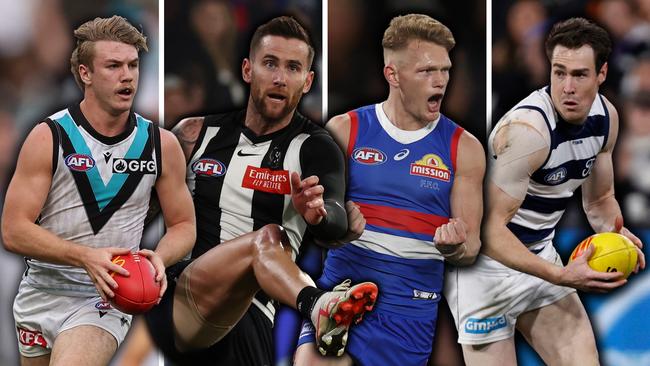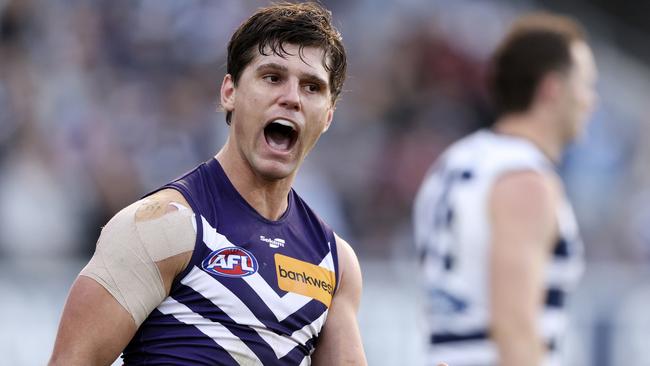A decade of AFL trading: See the clubs who dominate the player movement period
Carlton is the biggest buyer of the AFL trade and free agency market in the past decade, snapping up 29 players. But how many were winners? Find out what the numbers say on every club.

AFL
Don't miss out on the headlines from AFL. Followed categories will be added to My News.
The Giants have a revolving door and the Blues are shopaholics.
Belief that the Dockers are shedding players in large numbers is really a myth and Richmond has little interest in sitting at the trade table.
After pouring over a decade of trades and free agency and a total of 336 player movements, the patterns become clear and the chatter about Fremantle being overcome with players leaving the club is overblown.
The Dockers sit 11th in the league for players to have left in the past decade with 17 and the 2022 off-season in which five players left is the only real big hit of the decade.
Fremantle list boss David Walls has put on the table that the Dockers will study their ability to retain players after Liam Henry and Lachie Schultz departed for Victoria this year but he believes his club stacks up reasonably well.

“Every situation is different, even when you look at Liam and Lachie this year, it is different reasons,” he told Trade Radio recently.
“When you look at the numbers as well, we have 14 players which are our core players that we see taking us on and towards a premiership that are contracts to 2026 and beyond.
“That’s the largest number of any club in the competition. I feel like we have a lot of players committed in the long term and that is really positive they are invested and 100 per cent in.
“If you go back to 2017 and 2018, GWS lost more players than anyone and they were a point off the grand final. Collingwood is another club we looked at and they are quite similar in the numbers of players who have come and gone in that period.
“I think retention is important and something we will look at and need to make sure it is a real focus but also we have had a lot of players come into the club in that period as well.”
The Giants have sent players on flights elsewhere in staggering numbers compared to other clubs.
GWS has shipped out 44 players, miles ahead of second-ranked Geelong (25).
After having a list chock-full of young talent, the Giants haven’t topped up either, ranking last for players coming in the door on nine.
Player movement is dependent on a heap of factors: money, the pull of home and opportunity.
The Cats have lost a host of largely fringe players as opposition clubs pick off those just outside the best team, while clubs have largely had little interest in dragging players out of North Melbourne in recent years as the club struggled.
While essentially an entire list has left through trade or free agency, Giants CEO Dave Matthews believes the losses aren’t as big as they seem at his club.
“I still think we have a strong record in terms of player retention,” he said.
“We have basically kept everybody we wanted to except for Jeremy Cameron.
“I think when you are competing hard through to 2019 your salary cap starts to bulge a bit because you want to keep competing and you are extending contracts.
“At some stage you need a bit of a correction and that was really, the (Tim) Taranto and (Jacob) Hopper decisions last year.”
While GWS has lost plenty to other clubs, West Coast has hardly seen anyone go.
Remarkably just six Eagles have been traded or signed elsewhere as free agents in the last decade.
Richmond has rarely gone to the trade table, having brought in just 10 players directly from other clubs since 2014 and Sydney has brought in just 12.
That number sat at just eight for the Swans before a bumper off-season this year.
Adelaide has lost out most with free agents, having not signed a single one in the last decade while losing five.
And Carlton are the biggest buyers, snapping up 29 players in the past decade, showing the Blues have preferred the trade table to the draft for bringing in talent - most often from the Giants.
The numbers for the past decade include only trades and free agents, so players signed as delisted free agents don’t count or players snapped up for a second club through any of the drafts.
Check out where your club sits in the pecking order.
Originally published as A decade of AFL trading: See the clubs who dominate the player movement period



